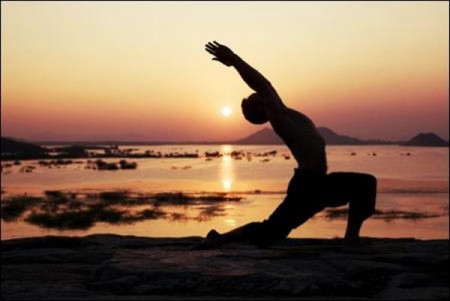Should a Christian do the Downward Dog?
This is not a trick question, but rather an issue raised by Baptist leader Albert Mohler that, like an egg beater, has whipped up the yoga community’s usual calm into a peaked, frothy fluster. Then again, aren’t we all a bit confused about this body-bending, mind-enhancing practice from the East?
In the name of clarity, here is an attempt to answer what yoga is—and what it isn’t.
The word yoga… Yoga traditions go back thousands of years, and today have spawned more than 100 schools, according to the American Yoga Association. This is partly why any discussion about the practice is so complicated. “In Sanskrit, ‘yoga’ can mean anything from an astronomical conjunction to yoking an animal to going to war; it’s what you put in front of the word—hatha, raja, tantric—that defines it,” explains David White, PhD, professor of religious studies at the University of California, Santa Barbara, and editor of the forthcoming book,Yoga in Practice.
“Not to say there is a pure hatha, raga, or tantric tradition—they were all mixed over the years in different ways by people in India, as well as the West, to attract followers.” In other words, what’s taught today in gyms, studios, and retreats around the country is inevitably a smoothie of traditions, usually featuring one ingredient—the physical poses—that was originally a very small part of the recipe.
Is yoga a religion? Categorically no, if you ask most teachers and devotees. “Simply put, yoga is not a religion,” says Aadil Palkhivala, who grew up in Bombay and studied with B.K.S. Iyengar before founding Purna Yoga. “It’s a process that helps you become physically stronger, more mentally alert, and more emotionally stable, so you can be a better Christian, Jew, Muslim, or whatever you care to be.”
Digging far back into the roots of yoga, however, scholars and historians hedge, noting that the ancient texts are quite difficult to understand. “My answer is that it can be” a religion, says Stefanie Syman, author of The Subtle Body: The story of yoga in America, the new book that prompted Mohler’s call for Christians to abstain. “As a spiritual technology, yoga has been attached to Hinduism, Jainism, and Buddhism, so it hasn’t been affiliated with a single religion—that’s true. But it developed to liberate the soul in this life, and how that was described and what theology was associated with it varies somewhat dramatically within the yoga traditions.”
White, who has read the original texts in Sanskrit, and is the author of Sinister Yogis, agrees with Syman. “Certain yoga schools do speak of ‘god,’ though not in the way that we do. The Sanskrit word used simply means master and not necessarily Master of the Universe; it could apply to a human. But there was never a church or gospel of yoga. It’s a very tricky question.”
So is it un-Christian to do yoga? There is no one answer, but some Christian yoga practitioners definitely make the opposite case. “Our practice combines Biblically-based meditation with yoga,” says Lisa Abbott, a spokesperson for Yawheh Yoga. “Each class opens with a prayer and introduces a selected portion of scripture that students focus on throughout.” Developed five years ago, Yawheh Yoga has certified nearly 100 teachers, including Abbott, who points out that the Bible (Joshua 1.8), instructs believers to meditate on His word. “We feel,” she says, “that we’re fulfilling a Biblical mandate to help Christians grow in their faith by meditating on His scripture.”
Yoga is about who can do the nuttiest pretzel pose. Not quite. “Traditionally the poses are actually a very small part of what you’re expected to do as a spiritual aspirant following the path of yoga,” says Syman. The breathing and meditative aspects are much more important.
Is the body a vehicle for reaching consciousness with the divine? Mohler objected to this aspect of yoga, but is it true? Possibly, if you go way back into the traditions. What’s more accurate, however, is yoga’s use of the physical poses to help prepare the mind for meditation, scholars say. As Palkhivala puts it, the physical practice, rather than trying to macrame your limbs, is intended to free the body of knots, “When you have aches and pains, it’s hard to focus the mind. And if you don’t take care of your body where are you going to live?”
Does yoga assume we can find divinity within ourselves? Many practitioners do believe in the idea that you can radically transform your consciousness and experience the divine, says Syman. It’s as if your own boundaries dissolve and you become connected with a larger spirituality. “That’s quite different from the Christian idea of a separate god or one you’re waiting to meet.”
What about chanting weird Sanskrit phrases you don’t understand? You could say the same for listening to Gregorian chants or repeating Hebrew prayers when you don’t speak the language. Mantra yoga, says Syman, is one of the techniques developed to aid in concentration. “We use the word ‘namaste’ which means ‘I bow to you,'” says Palkhivala, “which is an act of humility. We also use the Gayatri mantra, which simply invokes light, as in, illuminate my consciousness.”
Is the American version truly yoga? Face it, few of us have the time or savings to sit for hours and practice yoga as it was meant to be done. And if some purists compare the modern distillation as the Cheez Whiz of a glorious tradition, plenty of studies show that it improves health, from boosting mood to aiding weight loss to helping breast cancer patients recover.
“Much to the dismay of many,” says David Romanelli, “I started Yoga and Chocolate, Yoga and Wine, and Yoga for Foodies. But I always make the case that the world is a better place with more people doing any kind of yoga. And I’d actually like to invite Albert Mohler just to try a yoga class. I bet he’d love it.”
Visits: 93



